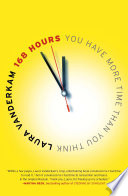

The core premise of '168 Hours' is that everyone has the same amount of time each week—168 hours. The author, Laura Vanderkam, emphasizes that effective time management is critical for personal and professional success. She encourages readers to assess how they currently spend their time and to identify areas where they can make adjustments. The idea is not just about working harder but working smarter. Vanderkam provides tools for tracking time, such as time logs, to help individuals understand where their hours go. By recognizing patterns, individuals can prioritize tasks that matter most and eliminate time-wasting activities. This concept is particularly valuable for busy professionals who often feel overwhelmed and underproductive. The key takeaway is that by consciously managing time, one can create space for what truly matters, leading to a more fulfilling life.
Continue readingVanderkam argues that many people fail to achieve their goals because they do not prioritize effectively. She encourages readers to identify their top priorities in both their personal and professional lives. By focusing on what matters most, individuals can ensure that their time is spent on activities that align with their values and long-term objectives. The book includes exercises to help readers clarify their priorities, such as creating a 'priority list' or vision board. This focus on priorities allows individuals to say no to distractions and commitments that do not serve their goals. Vanderkam illustrates this point with real-life examples of individuals who have successfully aligned their time with their priorities, demonstrating that it is possible to live a life that reflects one’s values.
Continue readingOne of the surprising insights from '168 Hours' is the importance of leisure time. Vanderkam argues that leisure is not just a luxury but a necessity for a balanced life. She discusses how engaging in hobbies, spending time with loved ones, and pursuing interests outside of work can enhance overall well-being and productivity. By intentionally scheduling leisure activities, individuals can recharge and return to their responsibilities with renewed energy and creativity. Vanderkam provides examples of how successful people incorporate leisure into their lives, showing that downtime can lead to better performance in work-related tasks. The message here is that leisure should not be viewed as a guilty pleasure but as an essential component of a well-rounded life.
Continue readingVanderkam stresses the importance of delegation and outsourcing to free up time for more critical tasks. Many individuals struggle with the belief that they must do everything themselves, leading to burnout and inefficiency. The book encourages readers to identify tasks that can be delegated, whether at work or home. This might include hiring help for household chores or collaborating with colleagues on projects. Vanderkam provides strategies for effective delegation, emphasizing the need to trust others and communicate clearly about expectations. By embracing delegation, individuals can focus on high-impact activities that drive their goals forward, ultimately leading to greater productivity and satisfaction.
Continue readingIn '168 Hours', Vanderkam highlights the value of flexibility in managing time. She argues that rigid schedules can often lead to stress and inefficiency. Instead, she advocates for a more adaptable approach, where individuals can respond to changing circumstances and seize unexpected opportunities. The author shares stories of people who have successfully navigated non-traditional work arrangements, such as remote work or flexible hours, allowing them to balance personal and professional commitments. By embracing flexibility, individuals can create a work-life balance that suits their unique situations, leading to increased happiness and productivity.
Continue readingVanderkam emphasizes the importance of mindfulness and reflection in time management. She encourages readers to regularly assess their time usage and reflect on their experiences. This practice can help individuals identify what is working and what is not, allowing for continuous improvement. The book suggests setting aside time for reflection, whether through journaling or meditative practices, to gain insights into personal habits and preferences. This self-awareness can lead to more intentional choices about how to spend time, ultimately fostering a sense of control and fulfillment.
Continue readingFinally, Vanderkam presents the idea that time is a valuable resource that should be treated with respect. She encourages readers to view their time as an investment, similar to money. By understanding the value of time, individuals can make more informed decisions about how to spend it. This perspective shift can lead to greater accountability and intentionality in daily activities. Vanderkam provides practical tips for maximizing time, such as batching similar tasks and eliminating distractions. The overarching message is that by treating time as a precious resource, individuals can create a life that reflects their true priorities and aspirations.
Continue reading